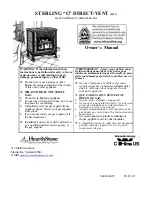
Installation Instructions
16
RELIEF VALVE
WARNING:
The pressure rating of the relief
valve must not exceed 150 PSI, the maximum working
pressure of the water heater as marked on the rating
plate.
The BTUH rating of the relief valve must not be less than the
input rating of the water heater as indicated on the rating
label located on the front of the heater (1 watt=3.412 BTUH).
Connect the outlet of the relief valve to a suitable open drain
so that the discharge water cannot contact live electrical
parts or persons and to eliminate potential water damage.
Piping used should be of a type approved for hot water
distribution. The discharge line must be no smaller than the
outlet of the valve and must pitch downward from the valve
to allow complete drainage (by gravity) of the relief valve
and discharge line. The end of the discharge line should not
be threaded or concealed and should be protected from
freezing. No valve of any type, restriction or reducer
coupling should be installed in the discharge line.
A new combination temperature and pressure-relief valve,
complying with the Standard for Relief Valves and
Automatic Gas Shut-Off Devices for Hot Water Supply
Systems, ANSI Z21.22, is supplied and must remain installed
in the opening provided and marked for the purpose on the
water heater. No valve of any type should be installed
between the relief valve and the tank. Local codes shall
govern the installation of relief valves.
TO FILL THE WATER HEATER
WARNING:
The tank must be full of water
before heater is turned on. The water heater warranty
does not cover damage or failure resulting from
operation with an empty or partially empty tank.
Make certain the drain valve is completely closed.
Open the shut-off valve in the cold water supply line.
Open each hot water faucet slowly to allow the air to
vent from the water heater and piping.
A steady flow of water from the hot water faucet(s)
indicates a full water heater.
CAUTION:
To reduce the risk of excessive pressures and
temperatures in this water heater, install temperature
and pressure protective equipment required by local
codes and no less than a combination temperature and
pressure relief valve certified by a nationally recognized
testing laboratory that maintains periodic inspection of
production of listed equipment or materials, as meeting
the requirements for Relief Valves and Automatic Gas
Shutoff Devices for Hot Water Supply Systems, ANSI
Z21.22. This valve must be marked with a maximum set
pressure not to exceed the marked maximum working
pressure of the water heater. Install the valve into an
opening provided and marked for this purpose in the
water heater, and orient it or provide tubing so that any
discharge from the valve exits only within 6 inches above,
or at any distance below, the structural floor, and does
not contact any live electrical part. The discharge
opening must not be blocked or reduced in size under
any circumstances.
ELECTRICAL CONNECTIONS
A separate branch circuit with copper conductors, overcurrent
protective device and suitable disconnecting means must be
provided by a qualified electrician.
All wiring must conform to local codes or latest edition of
National Electrical Code ANSI/NFPA 70.
The water heater is completely wired to the junction box at the
top of the water heater. An opening for 1/2" or 3/4" electrical
fitting is provided for field wiring connections.
The voltage requirements and wattage load for the water
heater are specified on the rating label on the front of the
water heater.
The branch circuit wiring should include either:
1.
Metallic conduit or metallic sheathed cable approved
for use as a grounding conductor and installed with
fittings approved for the purpose.
2.
Nonmetallic sheathed cable, metallic conduit or
metallic sheathed cable not approved for use as a
ground conductor shall include a separate conductor
for grounding. It should be attached to the ground
terminals of the water heater and the electrical
distribution box.
WARNING:
Proper ground connection is
essential. The presence of water in the piping and water
heater does not provide sufficient conduction for a
ground. Nonmetallic piping, dielectric unions, flexible
connectors, etc., can cause the water heater to be
electrically isolated.
Water heater junction box
Ground screw
Junction box cover
Wire connectors
L2
L1
















































